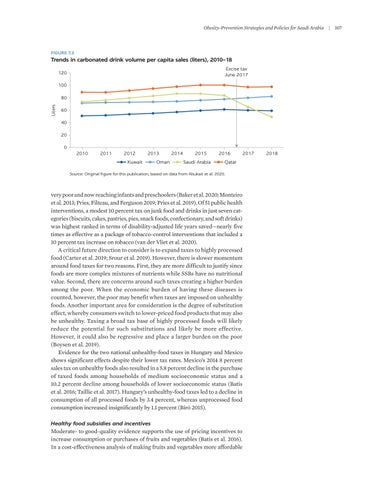Obesity-Prevention Strategies and Policies for Saudi Arabia
FIGURE 7.3
Trends in carbonated drink volume per capita sales (liters), 2010–18 Excise tax June 2017
120 100
Liters
80 60 40 20 0 2010
2011
2012
2013
Kuwait
Oman
2014
2015 Saudi Arabia
2016
2017
Qatar
Source: Original figure for this publication, based on data from Alsukait et al. 2020.
very poor and now reaching infants and preschoolers (Baker et al. 2020; Monteiro et al. 2013; Pries, Filteau, and Ferguson 2019; Pries et al. 2019). Of 51 public health interventions, a modest 10 percent tax on junk food and drinks in just seven categories (biscuits, cakes, pastries, pies, snack foods, confectionary, and soft drinks) was highest ranked in terms of disability-adjusted life years saved—nearly five times as effective as a package of tobacco-control interventions that included a 10 percent tax increase on tobacco (van der Vliet et al. 2020). A critical future direction to consider is to expand taxes to highly processed food (Carter et al. 2019; Srour et al. 2019). However, there is slower momentum around food taxes for two reasons. First, they are more difficult to justify since foods are more complex mixtures of nutrients while SSBs have no nutritional value. Second, there are concerns around such taxes creating a higher burden among the poor. When the economic burden of having these diseases is counted, however, the poor may benefit when taxes are imposed on unhealthy foods. Another important area for consideration is the degree of substitution effect, whereby consumers switch to lower-priced food products that may also be unhealthy. Taxing a broad tax base of highly processed foods will likely reduce the potential for such substitutions and likely be more effective. However, it could also be regressive and place a larger burden on the poor (Boysen et al. 2019). Evidence for the two national unhealthy-food taxes in Hungary and Mexico shows significant effects despite their lower tax rates. Mexico’s 2014 8 percent sales tax on unhealthy foods also resulted in a 5.8 percent decline in the purchase of taxed foods among households of medium socioeconomic status and a 10.2 percent decline among households of lower socioeconomic status (Batis et al. 2016; Taillie et al. 2017). Hungary’s unhealthy-food taxes led to a decline in consumption of all processed foods by 3.4 percent, whereas unprocessed food consumption increased insignificantly by 1.1 percent (Bíró 2015). Healthy food subsidies and incentives
Moderate- to good-quality evidence supports the use of pricing incentives to increase consumption or purchases of fruits and vegetables (Batis et al. 2016). In a cost-effectiveness analysis of making fruits and vegetables more affordable
2018
|
107






